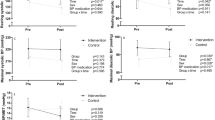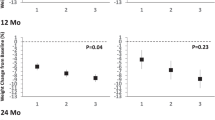Abstract
OBJECTIVE: To conduct a randomised trial of a physical activity (PA) intervention, The First Step Program (FSP) for adults with type II diabetes.
DESIGN: A 16-week intervention study and 24-week follow-up assessment.
PARTICIPANTS: A total of 47 overweight/obese, sedentary individuals (age=52.7±5.2 y; BMI=33.3±5.6 kg/m2) recruited through a diabetes education centre.
MEASUREMENTS: Primary outcome: daily PA assessed by pedometer (steps/day). Secondary outcomes: anthropometric measures (weight, BMI, waist girth, hip girth); indicators of cardiovascular health (resting heart rate and blood pressure); glycemic control (fasting glucose, insulin, HbA1c, glucose concentration 120 min postglucose load); plasma lipid status (total cholesterol, HDL cholesterol, LDL cholesterol, and triglycerides).
RESULTS: Relative to the CONTROL group, FSP participants increased their PA >3000 steps/day (approximately 30 min/day) during the intervention (P<0.0001). Waist and hip girth decreased (approximately 2–3 cm), but did not differ significantly between groups. Significant changes did not emerge for any of the other variables.
CONCLUSIONS: The FSP is a practical intervention that elicits an immediate and profound change in walking behaviour. Such change is an important ‘first step’ towards increasing the volume and/or intensity of PA necessary to improve long-term health outcomes in this largely sedentary and overweight or obese population. Relapse by 24 weeks indicates that other strategies such as booster sessions are needed to maintain lifestyle change. Further research must determine realistic and responsive health outcomes for this population that are achievable through practical, real-world programming.
This is a preview of subscription content, access via your institution
Access options
Subscribe to this journal
Receive 12 print issues and online access
$259.00 per year
only $21.58 per issue
Buy this article
- Purchase on Springer Link
- Instant access to full article PDF
Prices may be subject to local taxes which are calculated during checkout


Similar content being viewed by others
References
Ford ES, Herman WH . Leisure-time physical activity patterns in the US diabetic population. Findings from the 1990 National Health Interview Survey—Health Promotion and Disease Prevention Supplement. Diabetes Care 1995; 18: 27–33.
Hays LM, Clark DO . Correlates of physical activity in a sample of older adults with type 2 diabetes. Diabetes Care 1999; 22: 706.
Wei M, Gibbons LW, Kampert JB, Nichaman MZ, Blair SN . Low cardiorespiratory fitness and physical inactivity as predictors of mortality in men with type 2 diabetes. Ann Intern Med 2000; 132: 605–611.
Tudor-Locke C, Bell RC, Myers AM . Re-visiting the role of physical activity and exercise in the treatment of type 2 diabetes. Can J Appl Physiol 2000; 25: 466–492.
Manson JE, Hu FB, Rich-Edwards JW, Colditz GA, Stampfer MJ, Willett WC, Speizer FE, Hennekens CH . A prospective study of walking as compared with vigorous exercise in the prevention of coronary heart disease in women. N Engl J Med 1999; 341: 650–658.
Gregg EW, Beckles GL, Williamson DF, Leveille SG, Langlois JA, Engelgau MM, Narayan KM . Diabetes and physical disability among older US adults. Diabetes Care 2000; 23: 1272–1277.
US Department of Health Human Services. Physical activity and health: a report of the surgeon general. US Department of Health and Human Services, Centers for Disease Control and Prevention, National Center for Chronic Disease Prevention and Promotion: Atlanta, GA; 1996.
Searle MS, Ready AE . Survey of exercise and dietary knowledge and behaviour in persons with type II diabetes. Can J Public Health 1991; 82: 344–348.
Tudor-Locke C, Myers AM, Rodger NW, Ecclestone NA . Towards acceptable exercise guidelines in type 2 diabetes: an examination of current standards and practices. Can J Diabetes Care 1998; 22: 47–53.
Tudor-Locke C, Myers AM, Rodger NW . Development of a theory-based daily activity intervention for individuals with type 2 diabetes. Diabetes Educ 2001; 27: 85–93.
Tudor-Locke C, Myers AM, Bell RC, Harris S, Rodger NW . Preliminary outcome evaluation of The First Step Program: a daily physical activity intervention for individuals with type 2 diabetes. Patient Educ Couns 2002; 47: 23–28.
Tudor-Locke C, Myers AM, Rodger NW . Formative evaluation of The First Step Program: a practical intervention to increase daily physical activity. Can J Diabetes Care 2000; 24: 34–38.
Yamanouchi K, Takashi T, Chikada K, Nishikawa T, Ito K, Shimizu S, Ozawa N, Suzuki Y, Maeno H, Kato K, Oshida Y, Sato Y . Daily walking combined with diet therapy is a useful means for obese NIDDM patients not only to reduce body weight but also to improve insulin sensitivity. Diabetes Care 1995; 18: 775–778.
Leenders NYJM, Sherman WM, Nagaraja HN, Kien CL . Evaluation of methods to assess physical activity in free-living conditions. Med Sci Sports Exerc 2001; 33: 1233–1240.
Bassett Jr DR, Ainsworth BE, Swartz AM, Stratch SJ, O'Brien WL, King GA . Validity of four motion sensors in measuring moderate intensity physical activity. Med Sci Sports Exerc 2000; 32: S471–S480.
Tudor-Locke C, Bell RC, Myers AM, Harris SB, Lauzon N, Rodger NW . Pedometer-determined ambulatory activity in individuals with type 2 diabetes. Diabetes Res Clin Pract 2002; 55: 191–199.
Tudor-Locke C, Ainsworth BE, Whitt MC, Thompson R, Addy CL, Jones DA . The relationship between pedometer-determined ambulatory activity and body composition variables. Int J Obes 2001; 25: 1571–1578.
Bassett DR, Ainsworth BE, Leggett SR, Mathien CA, Main JA, Hunter DC, Duncan GE . Accuracy of five electronic pedometers for measuring distance walked. Med Sci Sports Exerc 1996; 28: 1071–1077.
Swartz AM, Bassett Jr DR, Moore JB, Thompson DL, Strath SJ . Accuracy of an electronic pedometer in adults with varying body mass index levels. Med Sci Sports Exerc 2003; 35: S283.
Tudor-Locke C, Myers AM . Methodological considerations for researchers and practitioners using pedometers to measure physical (ambulatory) activity. Res Q Exerc Sport 2001; 72: 1–12.
Canadian Society for Exercise Physiology. The Canadian physical activity, fitness and lifestyle appraisal. The Canadian Society for Exercise Physiology: Ottawa; 1998.
Tudor-Locke C, Myers AM . Challenges and opportunities for measuring physical activity in sedentary adults. Sports Med 2001; 31: 91–100.
World Health Organization. Obesity: preventing and managing the global epidemic—Report of a WHO consultation on obesity. World Health Organization: Geneva; 1998.
Tudor-Locke C . Taking steps toward increase physical activity: using pedometers to measure and motivate. Res Dig 2002; 3: 1–8.
Acknowledgements
This project was supported by a grant from the Canadian Diabetes Association. Additional support for the development of First Step Program educational resources was provided by a Canadian Diabetes Association Award supported by Bayer Corporation. The results herein were previously presented as a poster at the Canadian Diabetes Association Annual Meeting in 2001.
Author information
Authors and Affiliations
Corresponding author
Rights and permissions
About this article
Cite this article
Tudor-Locke, C., Bell, R., Myers, A. et al. Controlled outcome evaluation of the First Step Program: a daily physical activity intervention for individuals with type II diabetes. Int J Obes 28, 113–119 (2004). https://doi.org/10.1038/sj.ijo.0802485
Received:
Revised:
Accepted:
Published:
Issue Date:
DOI: https://doi.org/10.1038/sj.ijo.0802485
Keywords
This article is cited by
-
Preoperative walking recommendation for non-cardiac surgery patients to reduce the length of hospital stay: a randomized control trial
BMC Sports Science, Medicine and Rehabilitation (2021)
-
Improving insulin sensitivity, liver steatosis and fibrosis in type 2 diabetes by a food-based digital education-assisted lifestyle intervention program: a feasibility study
European Journal of Nutrition (2021)
-
Can consumer wearable activity tracker-based interventions improve physical activity and cardiometabolic health in patients with chronic diseases? A systematic review and meta-analysis of randomised controlled trials
International Journal of Behavioral Nutrition and Physical Activity (2020)
-
Systematic review of the prospective association of daily step counts with risk of mortality, cardiovascular disease, and dysglycemia
International Journal of Behavioral Nutrition and Physical Activity (2020)
-
Electrically assisted cycling for individuals with type 2 diabetes mellitus: protocol for a pilot randomized controlled trial
Pilot and Feasibility Studies (2019)



